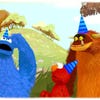Sesame Street: Once Upon a Monster
Fur play.
Of course, I found it interesting to see how Tim Schafer and his team tackled the obstacles of their first Kinect title and their first kids game, but it's a weird bonus for such a specific audience, especially since scenes, songs and sketches from Sesame Street would be far more appropriate. In a game that is so beautifully focussed on the needs of the very young gamer, it's a rare misstep and the only time when the game feels like it's following a generic template. Kids love rewards and progression, and those are both things that are central to game design, so it's a shame that beyond the immediate pleasures of interaction within the story the game doesn't do more to play with that concept.
These are all things that an adult gamer who spends far too much time thinking about game design theory would notice, of course. What about the people the game is designed for? Luckily, I have a ready-made QA department in the shape of Daisy, my five-year-old daughter. She's used to seeing her older brother help me out with reviews of Lego games and the like, but how would she fare with a game pitched directly at her?
Pretty well, all things considered. The core mechanics of the game - such as the action needed to turn the pages of the storybook and select a level - are intuitive enough that she's quickly able to do them herself, and she's instantly captivated by what's happening on-screen.
"He's a beautiful monster!" she gasps, as we wash the mud off something called Grrhoof, revealing pink and purple fur beneath. She loves playing with Kinectimal-style creatures called Puffalopes that must be coaxed nearer with biscuits and then tickled. She laughs at Cookie Monster being silly, and immediately grasps the need to copy what he's doing without the game having to spell it out laboriously. Clearly, the game taps into a child's understanding of "play" in a very natural way.
Over the long haul, however, her interest wanes. By the time we reach the end of our chapter (which takes around 20 minutes) she's wandering off to do other things, and only jumping back in when she sees me doing something that she wants to try, such as banging drums in time to the music.
Each story ends with a dance, and it's this part that really brings home everything the game gets right - and gets wrong. Like most little girls, Daisy loves dancing and she throws herself into the task with enthusiasm. About halfway through our celebratory boogie, however, her actions start to become less excited. Muttering starts. I pause the game and ask her what's wrong. "I want to show them a dance" she grumbles, bottom lip jutting out petulantly.
And, with the clarity of youth, she's homed in on Once Upon a Monster's biggest weakness. This is a game that spends a lot of time using Kinect to make the player follow instructions, but rarely uses it to allow the player to imprint their own ideas back into the game.
There are some dress-up stages, where you pick outfits for characters, and sometimes the game will let you choose whatever you want. There's a part, while putting on a monster play, where you teach flowers how to act sad, happy and excited. The Kinect microphone records your acting, then plays it back at a higher pitch as the flowers copy you. It's a lovely idea, but inexplicably the recording isn't used when the play is performed and the idea of the game copying the player, rather than the other way around, doesn't return until the very end.
After completing all the monster stories, we meet a smaller monster called Ramona. We get to narrate her story ourselves, in a sort of audio version of MadLibs. Cookie Monster and Elmo set us up and then Kinect records our interpretation of the cartoon images on-screen. "And then..." prompts Elmo, and the player can pick up with whatever they want. You could follow on with "Ramona went up the hill to find her friends" for example. Once it's all recorded, it plays back virtually seamlessly, and is a wonderful combination of Double Fine's storytelling prowess and the player's own imagination.
So why is this brilliant concept only used once, and right at the end? Who knows, but it brings home just where Once Upon a Monster could have elevated itself from delightful distraction to captivating classic. Let the player teach the monsters how to dance rather than the other way around. Let the player choose what flowers to plant, and where. For all its effortless charm, the game ultimately offers a window into an immersive world, fires up the imagination and then tells its young players to simply mimic the actions of others. That's enough to amuse kids, but it won't inspire them for long.












